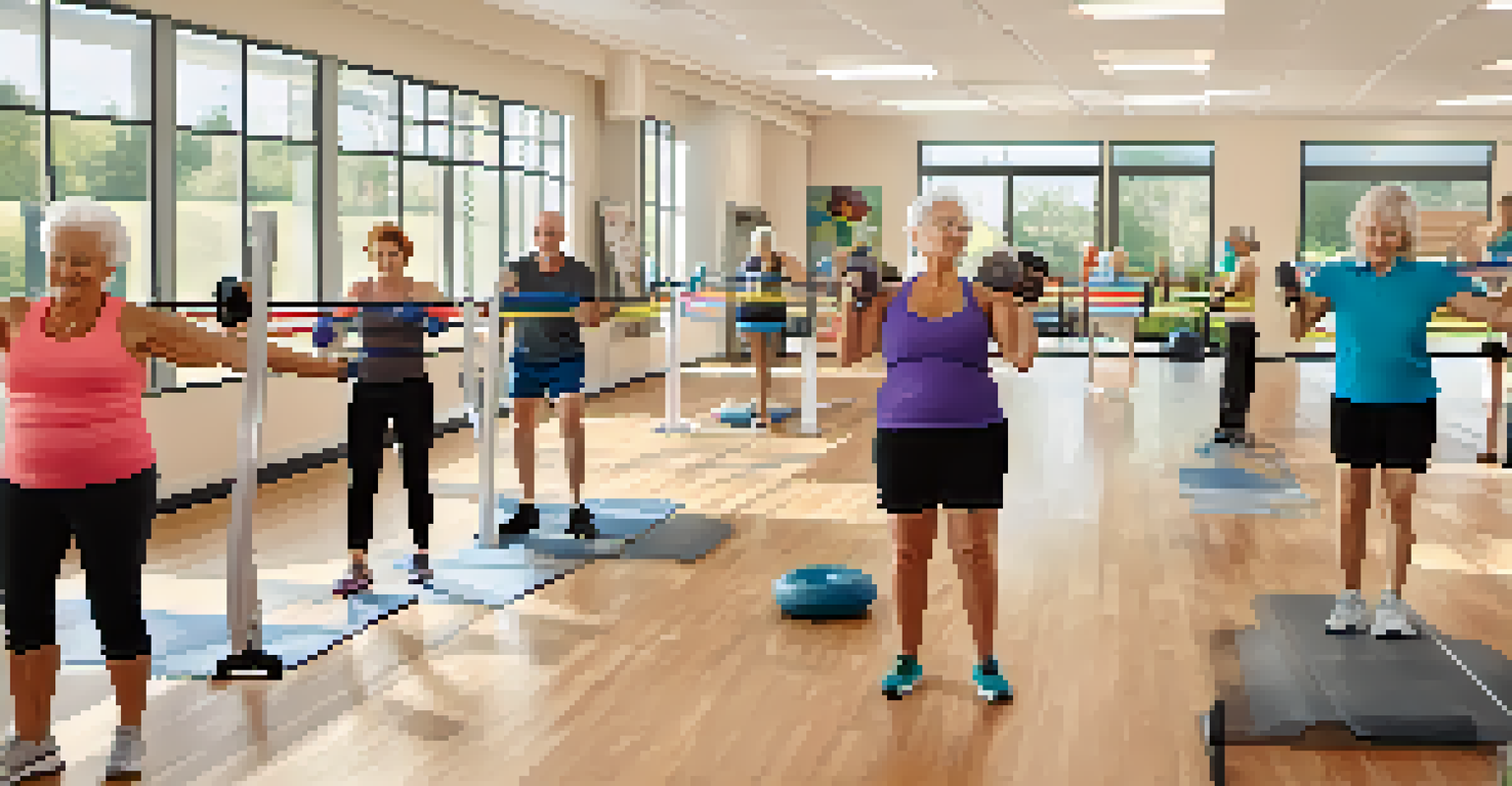How Strength Training Benefits Seniors: A Guide to Bodybuilding

Understanding Strength Training for Seniors
Strength training, often misunderstood, is simply about using resistance to improve strength. For seniors, this means engaging in exercises that enhance muscle mass and bone density. It’s not about lifting heavy weights like bodybuilders; rather, it focuses on safe, manageable activities tailored to individual capabilities.
Strength training is not just about lifting weights; it's about building a stronger life.
Many seniors may think strength training isn’t for them or worry about injuries. However, with proper guidance and a gradual approach, it can be incredibly beneficial. Simple exercises with resistance bands or light weights can significantly improve overall physical health without overwhelming the body.
Ultimately, strength training empowers seniors, providing them with the confidence to perform daily activities more easily. It’s about finding the right balance and understanding that every little bit counts towards better health.
Boosting Muscle Mass and Strength
One of the primary benefits of strength training for seniors is the increase in muscle mass. As we age, muscle mass naturally declines, which can lead to weakness and frailty. Engaging in consistent strength training helps counter this decline, allowing seniors to regain strength and independence.

Think of your muscles like a savings account; the more you invest in them through strength training, the more 'interest' you earn in terms of physical capability. Even small gains in muscle strength can lead to significant improvements in overall functionality, making it easier to carry groceries or climb stairs.
Strength Training Enhances Independence
Engaging in strength training helps seniors improve muscle mass and strength, enabling them to perform daily activities with greater ease.
Additionally, building muscle mass can enhance metabolism, allowing seniors to maintain a healthy weight. This is particularly important, as maintaining a healthy weight can prevent a host of age-related health issues.
Enhancing Bone Density and Joint Health
As we age, bones can become weaker and more susceptible to fractures. Strength training is an effective way to enhance bone density, which is crucial for seniors. Weight-bearing exercises stimulate bone formation, helping to keep bones strong and healthy.
The strongest factor for success is self-esteem. Believing you can do it, believing you deserve it, and believing you will get it.
Imagine your bones as a house; regular maintenance, like strength training, keeps it sturdy and less prone to damage. A stronger scaffold of bones can prevent falls and injuries, which are particularly dangerous for older adults.
Moreover, strength training can improve joint health by strengthening the muscles that support the joints. This added support can alleviate pain and stiffness commonly associated with conditions like arthritis, making movements smoother and more comfortable.
Improving Balance and Coordination
Balance is a critical aspect of maintaining independence as we age. Strength training contributes to better balance and coordination by strengthening the core and lower body muscles. When these muscles are strong, seniors are less likely to experience falls, which can result in serious injuries.
Consider balance as a skill that can be improved with practice. Engaging in strength training routines that focus on stability, like squats or lunges, can significantly enhance a senior’s ability to navigate their environment safely.
Boosting Bone and Joint Health
Regular strength training strengthens bones and joints, reducing the risk of fractures and alleviating pain from conditions like arthritis.
Additionally, improved balance can lead to increased confidence in mobility. Seniors may feel more secure moving about their homes or participating in social activities, knowing their bodies are strong and capable.
Boosting Mental Health and Well-Being
The benefits of strength training extend beyond the physical; they also include significant mental health improvements. Exercise, in general, is known to release endorphins, which can elevate mood and reduce feelings of anxiety and depression. For seniors, this can be a powerful motivator to stay active.
Imagine the sense of accomplishment that comes from lifting weights or completing a challenging workout. This feeling can boost self-esteem and foster a positive outlook on life. Regular participation in strength training can help seniors feel empowered and more connected to their bodies.
Moreover, the social aspect of joining group classes or working out with friends can combat feelings of isolation. Building relationships while engaging in physical activity can create a supportive community, enhancing mental well-being.
Supporting Chronic Disease Management
Strength training can play a vital role in managing chronic diseases that often accompany aging, such as diabetes, heart disease, and arthritis. By improving overall strength and physical function, seniors can better manage their symptoms and improve their quality of life.
Think of strength training as a tool in a toolbox for health management. It can help regulate blood sugar levels in individuals with diabetes and lower blood pressure for those with heart issues. This holistic approach to health is essential for seniors looking to maintain their independence.
Mental Health Benefits of Exercise
Strength training not only improves physical health but also boosts mental well-being by releasing endorphins and fostering social connections.
Additionally, many healthcare providers are recognizing the value of strength training in rehabilitation programs. For seniors recovering from surgery or illness, it can aid in regaining strength and function more efficiently.
Creating a Safe and Effective Strength Training Routine
Starting a strength training routine doesn’t have to be intimidating. The key is to begin slowly and choose exercises that suit individual fitness levels. Consulting with a healthcare professional or a certified trainer experienced in working with seniors can provide valuable guidance.
A well-rounded routine should include exercises targeting all major muscle groups, focusing on proper form over heavy weights. Activities like chair squats, wall push-ups, and resistance band exercises can be effective and safe options for beginners.

It’s also crucial to listen to your body and allow for adequate rest. Finding a balance between challenge and recovery will lead to sustainable progress and help prevent injuries, ensuring that strength training remains a positive experience.
Embracing Strength Training as a Lifestyle
Incorporating strength training into a senior's lifestyle can lead to lasting health benefits. It’s not just about hitting the gym; it can include activities like gardening, walking, or even playing with grandchildren. The more active a person is, the better their overall health will be.
Think of strength training as a lifelong journey rather than a destination. Setting personal goals, whether it’s lifting a certain weight or simply feeling stronger, can keep motivation high. Celebrating small victories along the way reinforces the positive impact of these activities.
Strength Training Boosts Independence
Engaging in strength training helps seniors improve muscle mass and overall strength, enhancing their ability to perform daily activities.
Lastly, fostering a supportive community or finding a workout buddy can enhance the experience. Sharing progress and challenges with others makes the journey enjoyable, turning strength training into a fulfilling and integral part of senior life.